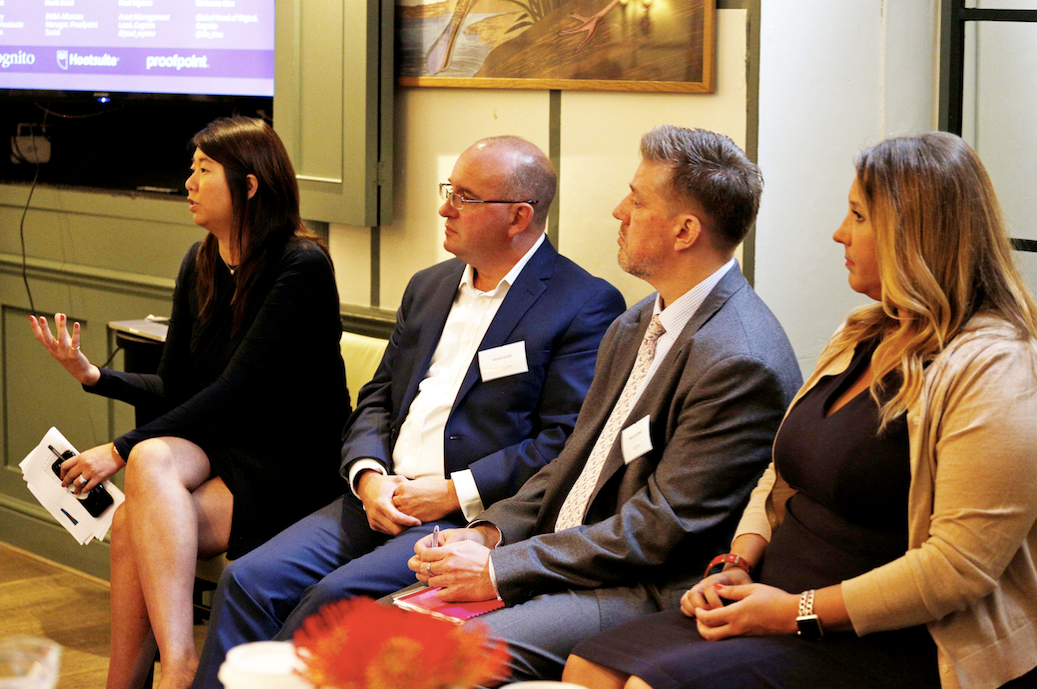Asset managers now realise their clients and prospects are on social, and so they must be as well. They’re starting to use social to support their brand and help their sales teams - but how can they stay secure and compliant?
That was the question on everyone’s lips as over 40 industry leaders gathered at London’s 1 Lombard Street to find out how to build a successful social media strategy.
Cognito, and our partners at Hootsuite and cybersecurity company Proofpoint, shared insights into social strategies and the evolving roles of technology, compliance and security.
Humanising the digital experience
First up was an introduction by Amy McIlwain, Global Industry Principal - Financial Services, Hootsuite, and best-selling author on social media in this most regulated of verticals.
Whilst financial services may be five years behind other industries, there’s the same need to plan for the future. And things are changing. 54% of advisers from one of the financial services firms that Hootsuite work with have scheduled a meeting with someone they first ‘met’ on social.
McIlwain stressed that there’s no longer a hierarchical marketing journey, with customers expecting more than one-way brand messages. They want conversation and instant interaction, as shown by the success of Monzo, the self-styled ‘bank of the future’.
Asset management firms need to rethink the competitor landscape – they’re now also up against the likes of Apple and Google. Consumers don’t see the distinction between sectors. They expect everyone to move in real-time.
She also covered how to activate a social business through social marketing (marketing/customer service), social selling (advisers/recruiters), and social advocacy (employee advocates).
A Q&A with a market leader
The focus then moved to a fireside chat with Mathew Greenlay, Head of Digital Delivery at industry giant Standard Life Aberdeen.
He explained how social starts with the content. You can have the best platforms and the most followers, but it doesn’t matter unless you have the right content.
To illustrate the point, he cited the successful launch of an Italian Twitter handle; a case study in local language empowerment and content marketing.
Then you need to find the people within your organisation who really get it, and make them the champions. Some of the strongest voices are those of your employees. But how can you counter risk?
A first step is simply to get them to share anything from the official channels as this will already be compliant, and most certainly not a financial promotion. Further enablement of sales people can be achieved through user accreditation programmes where they need to go through training, procedures and policies. This can remove the need for each individual post to go through the compliance department.
An expert panel
The morning concluded with a panel discussion looking at why social media is so important for asset management firms, the common challenges faced by all, and advice for those wanting to get started.
McIlwain was joined by Mark Read, EMEA Alliances Manager, Proofpoint Social, and Paul Wynne, Asset Management Lead and Director at Cognito. The panel was moderated by Vivienne Hsu, Cognito’s Global Head of Digital and Managing Director.
They had some useful advice for audience members keen to boost their social presence:
- Lead from the front. The C-Suite needs to do more than write the cheques. They need to get engaged, and ensure that their team is engaged. Reverse mentoring programmes can help to get senior buy-in – but don’t just get the youngest and most digitally-savvy person to lead the process; the mentor also needs to understand the business and its objectives.
- Don’t be scared! Combat fears about clients, technology, and regulation. Talk to each other and explore the tools on offer to help you through the social journey. Also explore new platforms. Asset management is stuck on the LinkedIn record, but the targeting capabilities on Facebook are frighteningly good.
- Consider the risk of getting involved, but also the risks of not getting involved. Firms can’t miss out on this opportunity to future proof their business. Provide employees with the right education, work with the right partners, and become comfortable with change.
- Explore data and personalisation. The phrase ‘Big Data’ is thrown around, but in reality, you only need a small amount of data to get started and better understand the buyer journey.
- Nail down appropriate metrics. Clicks themselves mean nothing. Take a more in-depth look at marketing effectiveness, such as a scoring matrix for brand awareness. Aim to find out the ‘Cost Per Completed Goal’, rather than just Cost per Click. And remember that increasing followers is great, but what really matters is followers from within your industry.




